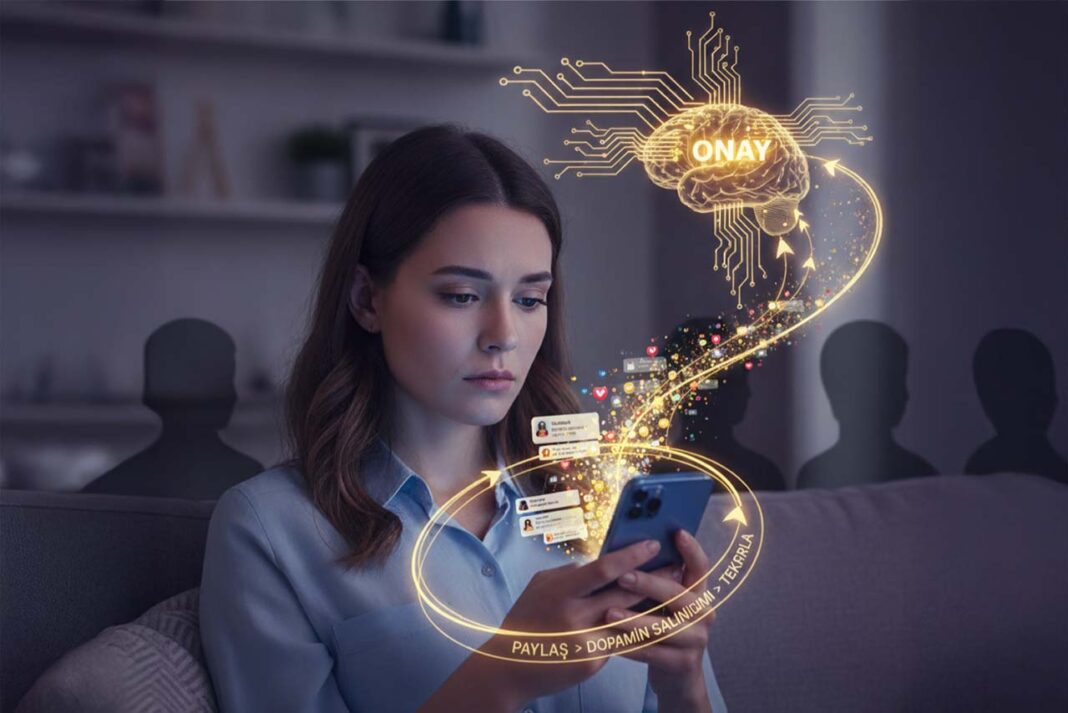We share a post, and a few seconds later, our hand reflexively reaches for our phone: “How many likes?” This action is part of one of the most powerful psychological cycles of the digital age. Social media is not just a communication tool; it’s like an experimental environment targeting our brain’s reward mechanism. Every “like,” every notification sound, every little heart icon triggers dopamine release in our brain, prompting us to engage in the same behavior over and over again. In psychological literature, this mechanism bears a strong resemblance to the theory of operant conditioning proposed by B.F. Skinner (1938). Skinner demonstrated that behaviors are repeated when they are reinforced by reward, and that rewards, especially those that come at irregular intervals, create addiction. Just as the pigeons in Skinner’s lab were fed at irregular intervals, we check our notifications without knowing how much approval we’ll get for each post. This transforms social media into the most powerful psychological reinforcement tool, and when combined with the human need for social approval, we create the invisible addiction of the modern age: addiction to being liked.
1. The Need For Social Approval
Humans’ search for approval didn’t begin solely with social media. Evolutionarily, acceptance and belonging to a group were fundamental to survival. According to Baumeister and Leary’s (1995) Belongingness Hypothesis, humans are motivated by the need to be accepted and admired by others.
Social media can replicate this evolutionary mechanism in a modern form as follows:
A “like” is now the digital equivalent of the approving gaze of a tribe.
Each “like” sends the message to our brain, “You are valuable, you are accepted.”
This may boost self-esteem in the short term, but in the long run, feeling valued becomes dependent on external approval. Over time, people begin to measure their own worth not so much on the feedback provided by social media. Thus, self-esteem becomes fixated on the “like rate,” and this cycle leads to the reshaping of personal identity on digital platforms.
2. The Dopamine Cycle And The Digital Reward Mechanism
When we share something on social media, receiving a like doesn’t just affect us emotionally; it also creates a measurable change in our brain.
Neuropsychological studies show that social rewards like “receiving a like” activate regions of the brain associated with the reward system, particularly the ventral tegmental area (VTA) and the nucleus accumbens (Meshi, Morawetz & Heekeren, 2013). These regions also function in natural pleasure situations like eating, achieving success, or bonding with a loved one. However, dopamine’s true function is different than we think. Most people think of dopamine as the “happiness hormone,” but it’s actually released when we anticipate a reward.
In other words, our brain produces dopamine not when we receive the like, but while we’re anticipating it. This means that the small thrill we feel when we hear a notification sound can be even stronger than the like itself. Over time, this sense of anticipation drives us to repeat the same behavior: to share, to anticipate, to check in.
3. Like Addiction: An Invisible Trap
While the feeling of being liked may initially seem like a harmless satisfaction, it can turn into an addiction over time. This addiction isn’t directed at a substance, but rather at the brain’s expectation of a reward. After a while, a person can’t find the same pleasure with every post, and a “tolerance” develops. They want to share more and receive more interaction because they can no longer find satisfaction as easily as they once did. This situation is very similar to behavioral addictions. Constantly checking notifications, trying to increase the number of likes, or feeling uneasy when “disliked” are all symptoms of this cycle. At some point, a person begins to measure their self-worth by the number of likes. This disrupts their internal balance; as self-worth becomes tied to external approval, self-confidence becomes fragile. In fact, they unknowingly surrender their identity to likes.
4. The Social Face Of Digital Approval
Likes are no longer just a matter of personal satisfaction; they have become a way of showing others who we are. By nature, humans evaluate themselves by comparing themselves to others; this can be explained by Social Comparison Theory, defined years ago by social psychologist Leon Festinger (Festinger, 1954). On social media, this mechanism is constantly alive: someone’s travels, another’s bodies, or another’s relationships are repeatedly displayed on screen. Over time, these images reinforce the notion that “others live better than me” and can intrinsically damage self-esteem. Some research shows that social media comparisons increase anxiety, loneliness, and feelings of inadequacy, especially in young people (Woods & Scott, 2016). The “like” button, once a means of facilitating communication, has now become a form of status competition. Being visible is now perceived as a prerequisite for feeling valued; invisibility has become almost synonymous with feeling worthless. Consequently, many people unknowingly transform their lives into a spectacle for others, rather than living them.
Conclusion
A “like” provides a few seconds of satisfaction, but in the long run, it can negatively impact our sense of identity. The digital age’s most powerful addiction hinges on the seemingly innocuous, a heart symbol. This cycle is strikingly similar to the pigeons in Skinner’s experiment: irregular rewards perpetuate behavior. But today, the difference is that the experimental chamber has become the phone in our hand. True freedom lies not in how many likes we receive, but in the ability to feel adequate without being liked. Learning to feed our need for validation not from the digital world, but from our own inner voice, is the quietest yet most profound resistance of the modern age. Perhaps the healthiest action today is to silence notifications and hear ourselves again.
References
Baumeister, R. F., & Leary, M. R. (1995). The need to belong: Desire for interpersonal attachments as a fundamental human motivation. Psychological Bulletin, 117(3), 497–529. https://doi.org/10.1037/0033-2909.117.3.497
Festinger, L. (1954). A theory of social comparison processes. Human Relations, 7(2), 117–140. https://doi.org/10.1177/001872675400700202
Meshi, D., Morawetz, C., & Heekeren, H. R. (2013). Nucleus accumbens response to gains in reputation for the self relative to gains for others predicts social media use. Frontiers in Human Neuroscience, 7, 439. https://doi.org/10.3389/fnhum.2013.00439
Skinner, B. F. (1938). The behavior of organisms: An experimental analysis. New York, NY: Appleton-Century.
Woods, H. C., & Scott, H. (2016). #Sleepyteens: Social media use in adolescence is associated with poor sleep quality, anxiety, depression, and low self-esteem. Journal of Adolescence, 51, 41–49. https://doi.org/10.1016/j.adolescence.2016.05.008


